Everybody loves to look fabulous in an all-white outfit. Luckily, there are few tactics that you can incorporate to ensure that white dresses, jackets, and t-shirts are looking white. If the clothes happen to get somehow grey, yellowed and dull, there are ways of restoring their brightness.
Three Steps To Keep White Clothes White
Contents
- Three Steps To Keep White Clothes White
- Step 1. Sorting and Separating
- Step 2. Cleaning White Dresses, T-shirts and Jackets
- Step 3. Drying White Clothes
- Household Items To Whiten Clothes
Step 1. Sorting and Separating
• Separate white t-shirts, dresses, and jackets from dark-and light-colored clothes
It is essential to clean whites from other colored clothes to prevent colors from moving and staining white garments.
• Separate all-white whites from whites with colors
This aspect helps avoid colors from transferring onto all-white clothes, irrespective of how small the patch may be. For instance, you should separate a white dress with green stripes from the all-white suit.
• Sort white clothes into different piles by their dirt level
This will avoid food, debris and other dirt on soiled white clothes from tinting other white outfits. For instance, if a white jacket is filled with soil after spending a day gardening, you should separate it from brighter and cleaner-looking whites.
• Sort the white clothes according to care guidelines
Tags and clothing labels offer washing guidelines for washing cycle, water temperature and whether or not you can utilize a bleaching agent. For instance, you should place all permanent-press clothing in one pile and all gentle-cycle clothing in another pile.
• Separate whites that collect lint from whites that produce fiber
This aspect stops dust from sticking and accumulating to fabrics from which fluff is tricky to remove.
Step 2. Cleaning White Dresses, T-shirts and Jackets
• Wash these clothes in hot water when possible
Hot water is essential at killing bacteria and germs and helps in ensuring that whites are bright at all times. You should use the correct water temperature as outlined on labels to prevent clothes from shrinking. Clothes designed from nylon, lycra, and certain cotton may shrink in hot water.
• Use cold water when cleaning stained white garments
Stains from items such as chocolate, tea, and wine come out better in cold water. This also avoids stains from moving onto other whites.
• Use the correct amount of detergent to your load by packaging guidelines
The amount of detergent to be used is based on the load size as well as the strength level of the detergent brand.
• Avoid using excess soaps
It leads to a filmy formation that attracts additional dirt.
• Use the manufacturer recommended type of bleach or the natural substitutes
Bleach is useful in whitening the clothes, but it can be irritating and toxic to sensitive skin. It is advisable to use chlorine bleach to help remove heavy stains. Baking soda, on the other hand, can be used to neutralize the toxicity of pure bleach. For ordinary white t-shirts and blanket sheets, Tide is the best solution. Give a try with Tide free samples here.
• Only use the right amount of bleach
Follow recommendations as outlined by the manufacturer because excessive bleach can stain your outfits yellow or gray.
• Use a bluing agent for neutralizing yellow stains on white fabric
Bluing agent formulas are known to make whites whiter by eliminating a small amount of blue dye to the water and remove the stains when one is rinsing.
Step 3. Drying White Clothes
• Move whites from the washing machine straight to the dryer instantly
When the washing machine halts. This action stops whites from developing mildew or mold due to staying in the washer for a prolonged period.
• Check all outfits for remaining stains before putting them in the dryer
This avoids dryer heat from setting in stains if stains are not entirely removed. Consider rewashing stained clothes in the washing machine as required before moving them to the dryer.
• Dry the white attire by care instructions
Some outfits may require you to ‘lay flat to dry,’ or commend a specific dryer setting. For instance, fabrics such as acrylic and nylon may need a lower temperature setting because these fibers have a tendency of absorbing little water.
Household Items To Whiten Clothes
• Use household ingredients that possess natural bleaching properties
These ingredients include white vinegar, lemon juice, hydrogen peroxide, and baking soda. These components are proven to make white outfits whiter without the added risks of skin irritation and toxicity.
• Hang the white attire to dry outside in the sun when possible
The UV rays of the sun possess a natural bleaching effect that helps in keeping the whites whiter. Additionally, drying in the sun may be more cost-effective in comparison to drying in the dryer.

